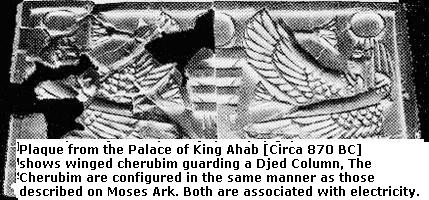|
|
|
The symbol of YHWHs sacred covenant with the Jews was probably a facsimile of a Leyden Jar, capable of producing thousands of volts of electricity. The concept of the Ark of Moses being an electrical device is not as eccentric as it initially appears to be.
|
|
The Old Testament contains a description of a device known as a Leyden Jar. The Biblical Ark of the Covenant that once stood in the Tabernacle in the Sinai wilderness , the Ark that led Moses and the Israelites into the Promised Land and the Ark that stood in the legendary Temple of Solomon. Common designs consist of a top electrode connected usually by a chain or rod to the inner surface of the jar and an external conductive foil wrap. Inner and outer surfaces of the Leyden jar store equal but opposite charges. The amount of charge that one of these devices can store is relative to the voltage applied to it times its capacitance. It was invented/discovered in the Modern era by German experimenter Ewald G. von Kleist in 1745 1. While experimenting with electricity, he touched his electric generator to a nail that was stuck into a medicine bottle through the cork and received a shock when he touched the nail. |
Exodus 25:10-28 gives explicit instructions for construction of the Ark, follow these instructions and the end result is a very large , very powerful Leyden jar / capacitor.
|
The materials that the Ark was constructed of, and the manner in which they were combined support the theory that the Ark was an electrical conductor. Gold, on the exterior of the Ark is a powerful electrical conductor, wood - just below the Gold is an excellent insulator ,Acacia wood. Acacia wood, used in the Arks construction acts as an insulator, while the gold is known as an excellent conductor. An electric charge would accumulate from constant exposure to static electricity in the Desertt climate . |
The Ark's upper surface has a rim of gold (a single coil of angels figures). Over the ark, the cherubs could form a spark gap, producing a dynamic radiance that would inspire awe in the observer, and could easily emit an electrical discharge strong enough to kill anyone that touched it.
|
|
The Ark has two gold Cherubim on its conductive lid, creating a double configuration in which one cherubim would be connected to the negative layer, the other to the inner, positive one, isolated from the outer layer. The cherubim acted as positive and negative terminals. Louis Ginzberg’s "Legends of the Jews " tells of ancient legends that refer to "sparks" emitted from the cherubim which comprised the lid/top of the Ark, as well as the positive and negative terminals.. |
Richard Andrews, in a Daily Mail article speculated that the ark worked as a giant capacitor which accumulated an electrical charge as it was transported through the desert. "If the Israelites had set out to construct a primitive accumulator, they could hardly have picked a better design than the Ark"
|
Nikola Tesla "The records, though scanty, are of a nature to fill us with conviction that a few initiated, at least, had a deeper knowledge of amber phenomena. To mention one, Moses was undoubtedly a practical and skillful electrician far in advance of his time. The Bible describes precisely, and minutely, arrangements constituting a machine in which electricity was generated by friction of air against silk curtains, and stored in a box constructed like a condenser. It is very plausible to assume that the sons of Aaron were killed by a high-tension discharge, and that the vestal fires of the Romans were electrical."
|
Several Biblical entries hint at the electrical nature of the Ark, in particular 2 Samuel 6 1-7
1 David again brought together out of Israel chosen men, thirty thousand in all. 2 He and all his men set out from Baalah of Judah to bring up from there the ark of God, which is called by the Name, the name of the LORD Almighty, who is enthroned between the cherubim that are on the ark.
6 When they came to the threshing floor of Nacon, Uzzah reached out and took hold of the ark of God, because the oxen stumbled. 7 The LORD's anger burned against Uzzah because of his irreverent act; therefore God struck him down and he died there beside the ark of God.
In 2 Samuel chapter 6 Uzzah unknowingly completed the circuit for an electrical discharge from the Ark to the ground when the oxen stumbled and "he reached out and took hold of the Ark". Poor Uzzah "died there beside the ark of God". Not because he pissed off a tyrannical , merciless Lord of Gods [Lord God] but because the basic laws of nature dictated such a result.
1.} Some accounts have the inventor being a Peter Musshenbroek
"Undoubtedly, the Ark of the Covenant is an instrument of High Magic: it was charged with electric force, thus any profane ones that dared to come close to the Ark died instantly.
In that Ark was the staff of Aaron, the tablets of the law, and the cup or Gomer. There is no doubt that the staff is phallic. There is no doubt that the cup symbolizes the yoni. So, dear brethren of mine, the Ark was powerful. It is stated that two cherubim were touching each other with their wings, and they were in the attitude of the man and the woman in copulation." Samael Aun Weor


